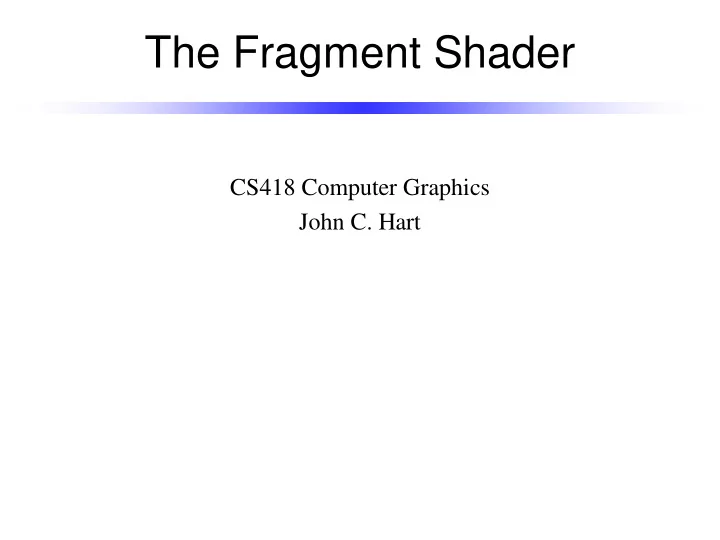

The Fragment Shader CS418 Computer Graphics John C. Hart
Fragment Pipeline Rasterization Model Vertex Clip Clip & Window Viewport Coords W2V Interpolation Coords Shader Coords Divide Coords Depth Fragment Pixels Fragments Fragments Test Shader
Model Coords GLSL Fragment Shader Vertex Shader Clip Coords Inputs: Clip/Div/W2V • vec4 gl_FragCoord (viewport coordinates) • bool gl_FrontFacing Viewport Coords • vec4 gl_Color, gl_SecondaryColor Rasterize • vec4 gl_TexCoord[gl_MaxTextureCoords] • float gl_FogFragCoord Fragments Fragment Shader Outputs: Fragments • vec4 gl_FragColor Depth Test • vec4 gl_FragData[gl_MaxDrawBuffers] • float gl_FragDepth (= glFragCoord.z) Pixels
clamp(x,a,b) b GLSL Functions a x a b • sin, cos, tan, asin, acos, atan, atan(n,d) mix(x,y,a) y • radians(deg), degrees(rads) x • pow, exp, log, sqrt a 1 0 • exp2, log2, inversesqrt(x) step(a,x) • abs, ceil, floor, fract, max, min, mod, sign, 1 • clamp(x,a,b) = min(max(x,a),b) x 0 a • mix(x,y,a) = (1.-a)*x + a*y smoothstep(a,b,x) • step(a,x) = (x < a) ? 0.0 : 1.0 1 0.0 if x < a x 0 a b • smoothstep(a,b,x) = 1.0 if x > b else t = clamp((x-a)/(b-a),0,1), t*t*(3-2*t)
GLSL Vector Math • dot(a,b) = a.x*b.x + a.y*b.y + a.z*b.z + … • length(a) = sqrt(dot(a,a)) • distance(a,b) = length(b – a) • cross(a,b) = vec3(a.y*b.z – a.z*b.y, …) • normalize(a) = a/length(a) = a*inversesqrt(dot(a,a)) • faceforward(n,v,nref) = dot(nref,v) < 0.0 ? -n : n • reflect(l,n) = l – 2*dot(l,n)*n • refract(l,n,eta) – refracts a vector l through a surface w/normal n and index of refraction eta – derivation in CS419 Production Graphics
Specular Reflection Phong Blinn n n h r l l f q q q f v q v r = 2( n l ) n – l h = ( l + v )/|| l + v || = L i k s c s cos n f = L i k s c s cos n f L o L o = L i k s c s ( v r ) n = L i k s c s ( n h ) n
Blinn Vertex Shader void main() { /* compute unit normal, vertex position, light vector and view vector in viewing coordinates */ vec3 n = normalize(gl_NormalMatrix*gl_Normal); vec3 p = gl_ModelViewMatrix*gl_Vertex; vec3 l = normalize(gl_LightSource[0].position – p.xyz); vec3 v = -normalize(p); /* eye is at origin */ /* compute halfway vector */ vec3 h = normalize(l + v); /* initialize color with reflection of ambient light */ frontColor = gl_FrontMaterial.ambient*gl_LightSource[0].ambient; /* f indicates if vertex faces light (f=1) or on dark side (f=0) */ float f = (dot(n,l) > 0.0) ? 1.0 : 0.0; /* add Lambertian diffuse reflection of direct light */ frontColor += f*dot(n,l)*gl_FrontMaterial.diffuse*gl_LightSource[0].diffuse; /* add Blinn specular reflection of direct light */ frontColor += f*pow(dot(n,h),gl_FrontMaterial.shininess) * gl_FrontMaterial.specular*gl_LightSource[0].specular; gl_Position = gl_ModelViewProjectionMatrix*gl_Vertex; }
Blinn Fragment Shader varying vec3 n; varying vec4 p; void main() { n = gl_NormalMatrix*gl_Normal; Vertex Shader p = gl_ModelViewMatrix*gl_Vertex; gl_Position = gl_ModelViewProjectionMatrix*gl_Vertex; } varying vec3 n; varying vec4 p; void main() { vec3 nhat = normalize(n); vec3 l = normalize(gl_LightSource[0].position – p.xyz); vec3 v = -normalize(p); /* eye is at origin */ vec3 h = normalize(l + v); vec4 c = gl_FrontMaterial.ambient*gl_LightSource[0].ambient; c += max(0,dot(n,l))*gl_FrontMaterial.diffuse*gl_LightSource[0].diffuse; int f; if (dot(n,l) > 0.0) c += pow(max(0,dot(n,h)),gl_FrontMaterial.shininess) * gl_FrontMaterial.specular*gl_LightSource[0].specular; gl_FragColor = c; }
Recommend
More recommend